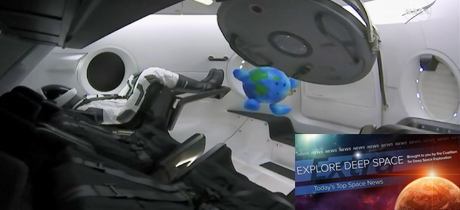In Today’s Deep Space Extra… Space Launch System (SLS) test of the RS-25 rocket engine was successful last Thursday. So far, so good for NASA’s Commercial Crew Program SpaceX Dragon Demo-1 test flight to the International Space Station (ISS). The European Space Agency (ESA) plans missions to assess the Moon’s surface for resources such as water and oxygen. China looks to place initial elements for an independent space station on the launch pad late this year.
Human Space Exploration
NASA cranks its Space Launch System (SLS) engine up for longest, most powerful test yet
Coalition Member in the News – Aerojet Rocketdyne
Orlando Sentinel.com (3/1): A test of the RS-25 rocket engine in line to power the first stage of NASA’s Space Launch System (SLS) burned for 510 seconds, 430 of those seconds at a record thrust, during qualification test last Thursday at NASA’s Stennis Space Center in Mississippi. The SLS first, or core, stage will be equipped with four of the RS-25’s, which trace their heritage to the space shuttle. Nine of the tests have been conducted since August, all to help certify the advanced engine controllers that function as the brains for the core propulsion system. watch video.
Commercial crew’s time approaches
Coalition Member in the News – Boeing
The Space Review (3/4): Launched early Saturday from NASA’s Kennedy Space Center (KSC), the agency’s demanding, uncrewed test flight of the Commercial Crew Program SpaceX Dragon Demo-1 mission to the International Space Station (ISS) has so far met or exceeded expectations. However, the spacecraft must still undock on Friday and splashdown in the Atlantic close to recovery vessels. Mark Geyer, director of NASA’s Johnson Space Center (JSC), cautioned ahead of the six day mission’s launch that the agency will not rush as it prepares for the first test flight with astronauts, perhaps in July.
Russia, U.S. to continue cooperation in manned space programs after Crew Dragon’s launch
Coalition Member in the News – Boeing
TASS of Russia (3/4): If NASA’s Commercial Crew Program and partners Boeing and SpaceX are successful in the certification of the CST-100 Starliner and Crew Dragon for the regular launches of crew members to the International Space Station (ISS), astronauts and cosmonauts will likely launch aboard both U.S. and Russian spacecraft.
Far out! First all-female spacewalk (ever) set for March
Florida Today (3/4): The first all-female spacewalk may be coming March 29 on board the International Space Station (ISS). The excursion would pair NASA astronauts Anne McClain, who arrived in December, and Christina Koch, who is one of three U.S. and Russian astronauts and cosmonauts scheduled to launch to the Station on March 14.
China preparing for space station missions
Xinhuanet of China (3/4): China’s Long March 5 heavy lift rocket and core module for a planned space station will be moved to a launch pad in the second half of 2019. Assembly complete for a news space station with access for international users is planned for 2022.
Space Science
The Hubble Space Telescope has a new camera glitch
Space.com (3/4): The Hubble Space Telescope’s prolific Advanced Camera for Surveys went dark suddenly late last week, according to a NASA status report. Engineers are looking into the cause, which occurred during what was to be a routine software load. In the meantime, other observing instruments aboard the 29-year-old space telescope are in good shape.
The engineers and scientists uncovering the Red Planet’s secrets
Rolling Stone (3/1): NASA’s Mars Insight lander, which succeeded in touching down on Mars in late November to study the planet’s interior, can claim an early breakthrough. Half its core mission team are women. The team beat the historical odds for a landing success on Mars, 40 percent. “It happened very organically,” says Julie Wertz Chen, a NASA mission simulation engineer, of the female composition. “Everyone was brought on for their skills, and then someone said, ‘Hey, there are as many women here as there are men.'”
European Space Agency (ESA) wants to mine the moon for oxygen and water
MIT Technology Review (3/4): The Moon may be not as barren as it appears. The European Space Agency (ESA) is teaming with the Ariane Group for a lunar lander mission in 2025 that will assess the soil of the Moon for the presence of oxygen and water. Other nations are expressing interest in lunar resources as well. China and India are interested in the presence of Helium-3, a solar element rare on the Earth that could be mined to generate a safe form of nuclear energy.
Daily Caller (3/3): Assessing the prospect for life across the solar system and beyond is a challenging goal, including whether it’s intelligent and especially whether life in some form is possible in extreme space environments. The challenge prompted NASA to establish the Center for Life Detection Studies in February. The center includes experts from George Washington University as well as Georgia Tech.
Other News
On national security | The SpaceX-ULA proxy war is heating up
Coalition Members in the News – Boeing, Lockheed Martin, Northrop Grumman, United Launch Alliance
SpaceNews.com (3/4): The Pentagon’s Office of Inspector General is pursuing an assessment of recent U.S. Air Force contract awards to U.S. launch services companies to determine whether the purchase agreements complied with criteria in place for new competitors. The SpaceX Falcon Heavy, for instance, was certified after only one launch. The inquiry is an indication of the “dog-eat-dog” competition now emerging in the launch services field, according to the op-ed.
Soon, hundreds of tourists will go to space. What should we call them?
Ars Technica (3/4): This year may see commercial suborbital rockets launching from the U.S. with passengers who have not undergone the traditional astronaut training provided by NASA and other global space agencies. Are they astronauts, space tourist or spaceflight participants? The answer may turn on the altitude they reach, 100 kilometers, or 80 kilometers — the border between the Earth’s upper atmosphere and space, a designation still under discussion.

